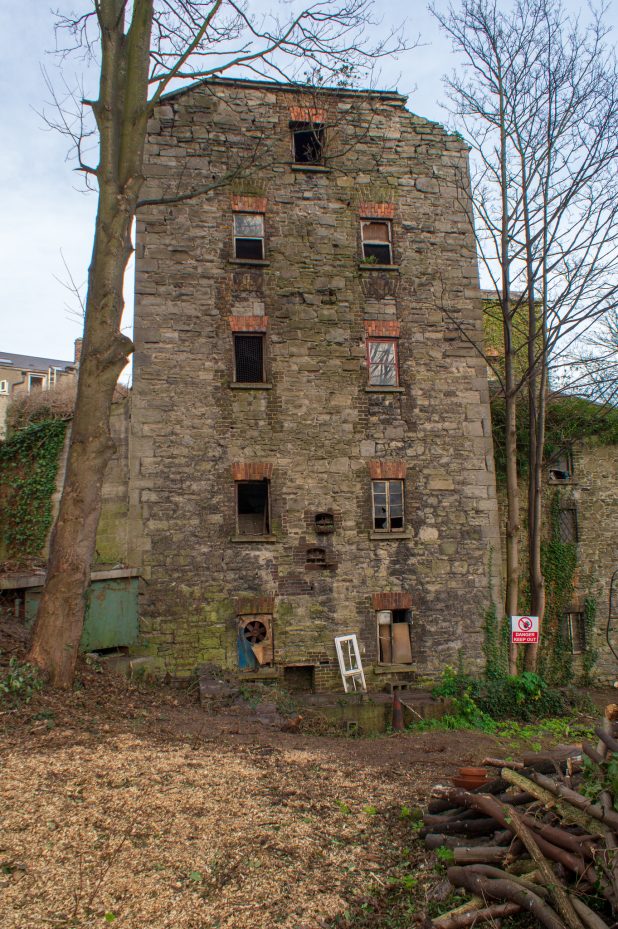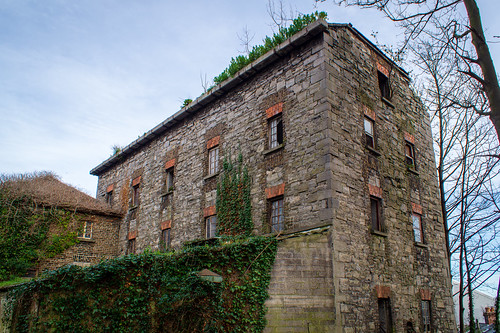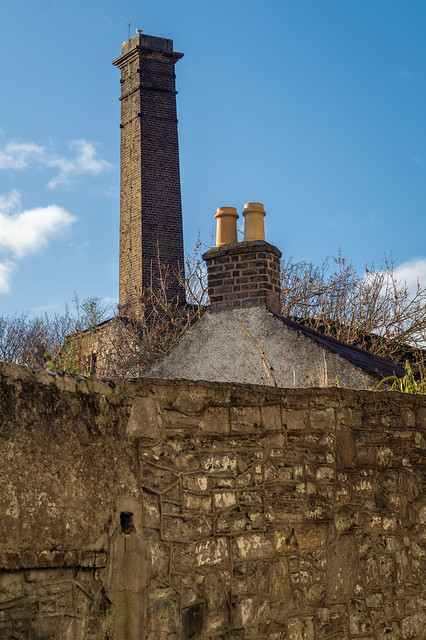Kilmainham Mill Part 2: Looking To The Future – In this part of my interview with Maurice Coen we discuss the current state of the mill, what work needs to be done and what the future holds for the former flour mill.
Part 1 of this article viewable here
The mill has been saved from developers but now it needs to be saved from collapse. According to Maurice there is “a hell of a lot of work to be done”. This was never going to be an easy process and it’s a long way from completion. It looks like it could be a minimum of 10 years before it’s fully completed.
Work has already begun on making the grounds safer. An initial budget of around €200,000 was made available for landscaping, securing of the building and security. Currently security is on the grounds 24/7 but this proving to be very expensive so plans are in place to install cameras which will be remotely monitored. MCD Landscapes has been given the task of clearing the grounds and so far they have concentrated on cleaning up around the mill race area. They have also cut back and pruned some of the trees, many of which were dangerous or overhanging onto people’s properties.
The roof was in particularly bad shape. Buddleia had been growing on top of the building and was causing severe damage, this has now been cleared. Large puddles of water had gathered on the roof, over a foot of water in some cases, and were putting a massive pressure on the structure; which desperately needed to be alleviated. The plan is to re-slate the roof using reclaimed roof tiles.
Japanese Knotweed is causing serious damage throughout the grounds. The invasive plant grows very rapidly and is able to grow through concrete and tarmac. It is very difficult to remove Japanese knotweed, usually requiring both physical and chemical treatment to get rid of and can take a number of years to fully eradicate.
A lot of other work needs to be done too. There was a water mains leak under the road on Rowserstown Lane that caused significant damage. The leak has since been fixed but the damage it caused needs to be repaired. The floors need to be re-secured and some of the timber supports are rotting and will have to be replaced. The inside has become quite damp and this has led to a serious mould problem. They will be using a mesh to cover the windows to allow air to circulate through better. All of the electrics will have to be redone. Asbestos is another massive issue that will need to be dealt with as soon as possible.
There has been some really good work done so far but as Maurice describes it “they’re only after brushing off the countertops” and the Dublin City Council are committed to seeing this project through. When I asked if the council may sit on this project I get a very assured answer of “no, they are fully committed to this”. The DCC have started off on a strong foot and have been very active in involving the residents and the heritage society. They are fully committed to meeting with Mr Coen as head of the residents group to discuss any problems that local residents may have. They have also agreed to regular meetings with the heritage society headed by Michael Flanagan as well as the residents and anybody who has concerns about the project.
https://www.flickr.com/photos/158710879@N03/32278910947/in/album-72157676827420907/
There is an expert team of people now looking after this project. Howley Hayes Architects, Lisa Eddin – Cora Structural Engineers, Austin Reddy Quantity Surveyors, Franc Myles – Archaeologist and MCD Landscapes are the “dream team” tasked with the restoration of Kilmainham Mill.
Projects on this scale are never cheap and Maurice gave an honest estimate of the cost. “Not much change out of €20 million I wouldn’t think. Henrietta Street cost, I think, €5.2 million for a house and we’ve got a hell of a lot of house to work at but it’s going to be well worth it”. 14 Henrietta Street is a Georgian townhouse and former tenement building that had been left to rot until Dublin City Council stepped in, restored it and turned it into a museum.
https://www.flickr.com/photos/158710879@N03/32278908637/in/album-72157676827420907/
Financing the restoration will rely mostly on grants. Initially they have a grant of €200,000, but that won’t last forever so the next plan is to apply for a further €500,000. Fáilte Ireland has grants available for large tourism projects and Kilmainham mill would be an ideal candidate to receive this type of funding. There are also a number of grants available from the European Union for heritage projects and Maurice sees absolutely no reason why they wouldn’t be able to get their hands on a few of them.
So what’s next for the mill? At this moment there is nothing on the table. The area will need to be made safe before plans can officially be drawn up. A museum would be ideal, the machinery restored, a nice walkway around the grounds with a gift shop and a cafe. It could be something that both locals and tourists could appreciate. When asked what he would like to see happen to the mill Maurice said “we’d like to see a cultural hub in there and it would be part of the, I wouldn’t call it the Kilmainham triangle but the Kilmainham Quadrangle, which is the gaol, the courthouse, the royal hospital and now the mill”.
It will probably be two years before we see any significant developments. By then the roof will be fixed, the building will be structurally sound, asbestos and mould will be gone, the land cleared, Japanese knotweed eradicated and the site will be safe to enter. But whatever is going to happen next with the mill, Maurice, the heritage society, the residents group and the save the mill campaigners can all sleep easy knowing that they’ve achieved what they set out to do, they saved the mill.
https://www.flickr.com/photos/158710879@N03/45434756714/in/album-72157676827420907/
All Photos By Stephen Davis












Fantastic finale Eoghan bravooo
Congratulations to Shane and all the group associated with Kilmainham Mill.
I Grew up on Emmet Road in the 40’s and 50’s and I can well remember the very poor condition of Kilmainham Jail before the restoration commenced.
Well done to all and Good Luck.